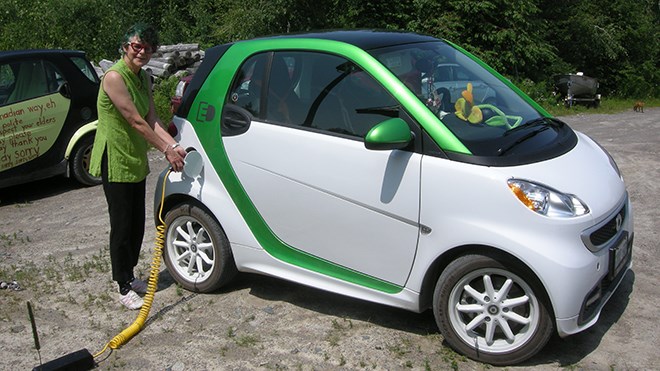I've just welcomed a recent addition to my personal carbon footprint protection plan. Smarty 2 is my new all electric Smart For Two car. What this means is that I no longer need to put an oil product in my car to make it run. It also means I will not be contributing carbon dioxide to this world - I am sure the atmosphere is smiling from horizon to horizon.
For those people who wonder of the impact of driving an electric car, it is measurable. Put in kilometres per 100 Litres, the equivalent for an all electric car is approximately 1.0 Litres per 100 kilometres (or less). Compare that to the 6.0+ Litres per 100 kilometres of the average North American car.
If you think that electric cars are a fad, well think again. The Ontario government's goal is to have 2 out of every 10 people in Ontario driving an electric car by 2020. That's only 6 years away. That's 1 out of every 5 cars running on clean efficient Ontario electricity.
There is presently an incentive of a rebate of up to $8,500 for purchasing or leasing of an electric car.
One of the key elements of any electric vehicle is its battery. A battery is an electrochemical energy storage device that can release an electrical charge when needed. Batteries may be made up of one or more cells, which can be connected together (in series) to provide a higher voltage. For example, a typical 12-volt car battery is made up of six cells connected together internally. A battery pack for a battery electric vehicle (BEV) may have hundreds of individual cells. Battery characteristics that are particularly important for automotive use include their energy density and power density.
Energy density is a measure of how much energy a battery can hold. The higher the energy density, the longer it will last before needing to be recharged.
Power is the rate at which energy is used. Power density is a measure of how much power a battery can deliver on demand – that is, how quickly it can release its energy (and conversely, how quickly it can be recharged).
Lithium-ion batteries are commonly used in cell phones and laptop computers and are becoming the battery of choice for electric and plug-in hybrids. The most important thing to know about charging an electric vehicle, whether it’s a battery electric vehicle or a plug-in hybrid, is that it is as easy as plugging in a toaster.
Most electric cars can be charged overnight in a standard 120 V household outlet. However, almost all models can be recharged more quickly – approximately 5 hours – in a 240 V outlet, which is the same type of outlet needed for domestic clothes dryers, and which can easily be installed by a qualified electrician. Super chargers are available to charge in as little as a half-hour.
Charging stations, similar to gasoline stations, exist and more are being developed throughout North America. In Ontario, for instance, some GO Train stations offer parking spaces with outlets for electric vehicles. In Sudbury, the Quality Inn is offering their patrons a super charger at no cost. Congratulations to a very progressive manager.
The average Canadian commutes approximately 30 kilometres per day. My electric car has a range of 138 kilometres per charge, compared with 500 km or more between fill-ups for most conventional cars. For most consumers, that range is well within their current commute, making electric cars a more viable, and more fuel efficient option as a commuter car.
That is not to say that electric cars cannot be used for travelling. The Tesla for example can go up 500 kilometres per charge, and newer technology will surely extend that. The cost of recharging an EV is similar to the cost of heating a 40 gallon water tank.
My electric car produces zero emissions compared to vehicles using internal combustion engines. According to Forbes, the American Council for an Energy Efficient Economy ranked the Smart For Two Electric Drive the "greenest" car for 2014.
My question to you then is, when are you going to go greener?
-Mercedez Quinlan
